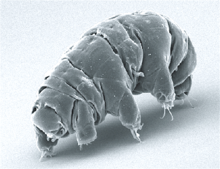Milnesium tardigradum
| Milnesium tardigradum | |
|---|---|
 |
|
| SEM image of Milnesium tardigradum | |
| Scientific classification | |
| Kingdom: | Animalia |
| Phylum: | Tardigrades |
| Class: | Eutardigrada |
| Order: | Apochela |
| Family: | Milnesiidae |
| Genus: | Milnesium |
| Species: | M. tardigradum |
| Binomial name | |
|
Milnesium tardigradum Doyère, 1840 |
|
| External identifiers for Milnesium tardigradum | |
|---|---|
| Encyclopedia of Life | 1053491 |
Milnesium tardigradum is a cosmopolitan species of tardigrade that can be found in a diverse range of environments.M. tardigradum has also been found in the sea around Antarctica.M. tardigradum was described by Doyère in 1840.M. tardigradum contains unidentified osmolytes which could potentially provide important information in the process of cryptobiosis.
M. tardigradum has a symmetrical body with a total of eight legs. The M. tardigradum utilize claws, a distinctive feature for this tardigrade species. The total length of the body varies, with some measuring up to 0.7 millimeters in length.
M. tardigradum has been found to have a high level of radioresistance. In 2007, individuals of two tardigrade species, Richtersius coronifer and M. tardigradum, were subject to the radiation, near-vacuum and near-absolute zero conditions of outer space as part of the European Space Agency's Biopan-6 experiment. Three specimens of M. tardigradum survived. The M. tardigradum is able to cope with high amounts of environmental stress by initiating cryptobiosis. It is found that during this state, the internal organic clock of the M. tardigradum halts, thus the cryptobiotic state does not contribute to the aging process.
M. tardigradum is an omnivorous predator. It typically feeds on other small organisms such as algae, rotifers, and nematodes. There have also been recorded cases of M. tardigradum feeding on other smaller tardigrades.
M. tardigradum has been phylogenetically linked to arthropods. Although the extent of the relationship is still debated, there is evidence that tardigrades and arthropods have a close evolutionary history.
...
Wikipedia
